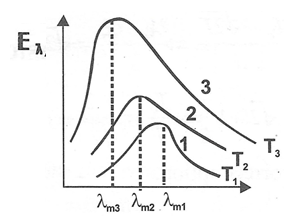11th And 12th > Physics
HEAT TRANSFER MCQs
:
B
As the temperature differences are small, we can use Newton's law of cooling.
dθdt=−k(θ−θ0)dθθ−θ0=−kdt ...(i)
Where k is a constant,θ is the temperature of the body at time t and θ0 = 16∘C is the temperature of the surrounding. We have,
∫360c400cdθθ−θ0=−k(5min)In360c−160c400c−160c=−k(5min)
or, k=−In(5/6)5min
or, If t be the time required for the temperature to fall from 360C to 320C then by (i),
∫320c360cdθθ−θ0=−ktIn320c−16c360c−160=−In(5/6)t5mint=In(4/5)In(5/6)×5min=6.1min
The graph shown in the adjacent diagram, represents the variation of temperature (T) of two bodies, x and y having same surface area, with time (t) due to the emission of radiation. Find the correct relation between the emissivity (e) and absorptivity (a) power of the two bodies. (IIT JEE 2003)
:
A
From the graph it is clear that initially both the bodies are at same temperature but after that at any instant temperature of body x is less than the temperature of body y. It means body x emits more heat i.e., emissivity of body x is more than body y ∴ex>ey and according to Kirchhoff's law good emitter are also good absorber so ax>ay.
:
A
According to Wein's displacement law λm×T = Constant
Here λm<λm2<λm1 ⇒T3>T2>T1
The temperature of Sun is higher than that of welding arc which in turn is greater than tungsten filament.
Therefore T3 is the Sun's temperature, T2 the welding arc's and T1 the tungsten filament's.
A spherical ball A of surface area 20 cm2 is kept at the centre of a hollow spherical shell B of area 80 cm2. The surface of A and the inner surface of B emit as blackbodies. Assume that the thermal conductivity of the material of B is extremely poor and that of A is very high and that the air between A and B has been pumped out. The heat capacities of A and B are 42 J/∘C and 82 J/ ∘ C respectively. Initially the temperature of A is 100 ∘ C and that of B is 20 ∘ C.Find the rate of change of temperature of A and that of B at this instant.
:
D
The inner surface of B radiates at a rate of ΔQΔt=σABT4A,
where σ→ stefan's constant
AB →Area
TB → Temperature
Similarly, A radiates ΔQ2Δt=σABT4A
Now, all the radiation from inner surface of B goes inside the hollow of the shell, as B is a very poor conductor. So, this radiation falls on A, and A being a blackbody absorbs all the radiation falling on it! And it being a good conductor the heat travels to the centre almost instantly, thus making the temperature uniform throughout the ball. Similarly, all the heat radiated by A is completely absorbed by inner surface of B, and none of it is lost to the surrounding as B is a very poor conductor.
∴ Net heat lost by B = Net heat gained by A =σ(ABT4B−AAT4A)
= 5.67×10−8×(80×293.1s4−20×373.1s4)×10−4
= 1.15 w
Now this is equal to specific heat ×dtemperaturedTime of both A and B
∴dTAdt=1.1542∘c/s=0.03∘c/s
dTBdt=1.1582∘c/s=0.01∘c/s
:
B
Stefan's law: ΔQΔt=eσAT4
For an ideal radiator e = 1 ⇒ΔQΔt=6×10−8×1.6×(273+37)4
=6×10−8×1.6×314×104
= 887 J per second.
Polyurethane is quite good for cold weather for jackets and blankets. However, thermal emergency blankets or space blankets are often made up of something similar to aluminum foil and used by astronauts to avoid hypothermia when stuck in subzero temperature. Why do you think it is a good choice?
:
A
'Aluminum foil like' thermal blankets are designed to reflect most of the radiation, or infrared radiation.
Also, they are shiny! This makes them easy to spot from helicopters etc, in case of rescue operations.
So, all in all, a must have for campers!
:
C
Let the temperature of the coil be T. The coil will emit radiation at a rate Aσ T4. Thus,
1000W =(0.020 m2)×(6.0×12−8W/m2−K4)×T64
or, T4=10000.020×6.00×10−8K4
=8.33×1011K4
or, T=955 K.
:
C
For all modes of heat transfer ΔQ∝ Area,A.So we should choose the shape with minimum area for minimum heat transfer.
(a)For cubical:
Volume, V = a3=1l,∴a=1 dm(decameter)
Area, A = 6a2=6 dm2
(b)For conical: V= π r2h3, but given r=h,r=313π dm
A=πr(√2r)+πr2
= 7.354 dm2
(c)For Sphere:
V=43πr3, ∴r=(34)13dm
A=4πr2=4.84 dm2
(d) For Cylinder:
V=π×r2×r ∴r=1π13dm
A=2πr2+2πr.r=5.86 dm2
As Sphere has the least area among these, it will be the shape with minimum heat loss. In fact sphere is the shape with the minimum surface area among all possible shapes!
:
D
The energy radiated per second by a black body is given by Stefan's Law as Et=σT2×A where A is the surface area of the black body
EtσT4×4πr2
Since black body is a sphere, (A=4πr2).
Case(i)
Et=450,T=500K,r=0.12m,
∴450=4πσ(500)4(0.12)2 .....(i)
Case(ii)
Et=?,T=1000K,r=0.06m,
dividing (ii) and (I) we get,
Et450=(1000)4(0.06)2(500)4(0.12)2=2422=4
⇒Et=450×4=1800W
(d) is the correct option.
:
B
As the temperature differences are small, we can use Newton's law of cooling.
dθdt=−kt(θ−θ0)
dθθ−θ0=−kdt
or, ...(i)
Where k is a constant, θ is the temperature of the body at time t and θ0=16∘C is the temperature of the surrounding. We have,
∫36∘C40∘Cdθθ−θ0=−kt(5 min)
ln36∘C−16∘C40∘C−16∘C=−kt(5 min)
or,
k=−ln(56)5 min
or, .
If t be the time required for the temperature to fall from 36∘C to 32∘C then by (i),
∫32∘C36∘Cdθθ−θ0=−kt
or, ln32∘C−16∘C36∘C−16∘C=−ln(56)5 min
or, t=ln(45)(ln(56)×5min
= 6.1 min.
Alternative method
The mean temperature of the body as it cools from 40∘C to 36∘C is 40∘C+36∘C2=38∘C The rate of decrease of temperature is
40∘C+36∘C5min=0.80∘C/min .
Newton's law of cooling is
dθdt=−k(θ−θ0)
or, -0.8∘C/min = - k(38∘C - 16∘C)=-k(22∘C)
or, k=0.822min−1.
Let the time taken for the temperature to become 32∘C be t.
During this period,.
The mean temperature is
Now,

















